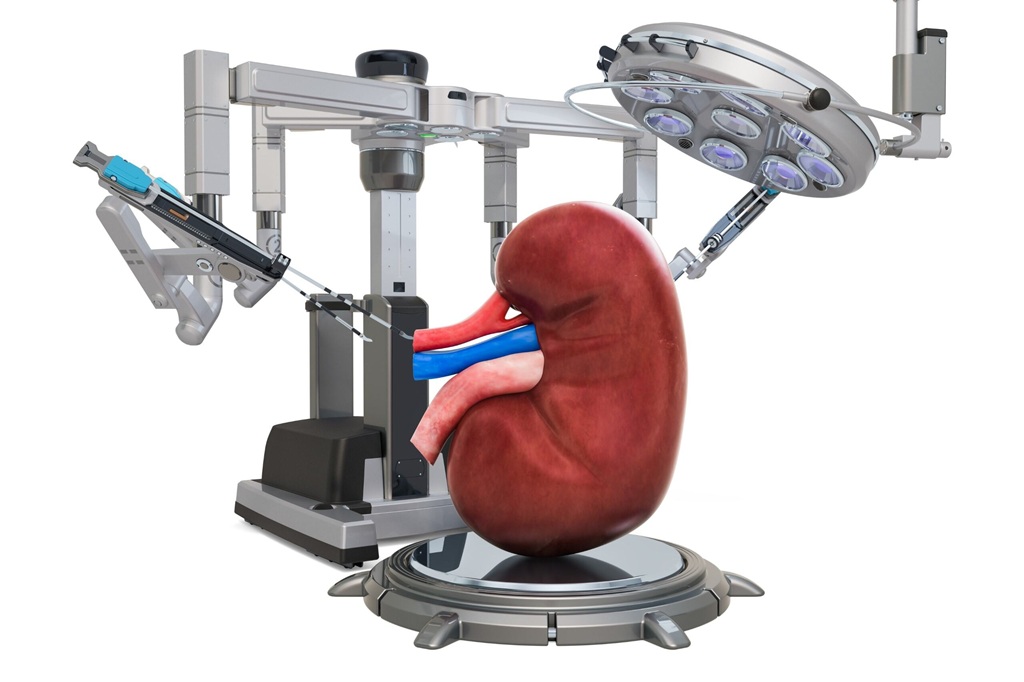Robotic surgery in urology allows surgeons to operate with unmatched precision, using robotic instruments that provide enhanced control and stability.
This high level of accuracy minimizes the risk of complications, such as inadvertent tissue or nerve damage, which is especially crucial in delicate areas like the urinary tract. Since robotic surgery is minimally invasive, it reduces blood loss and post-operative pain, which helps patients recover faster and the recovery process is more comfortable.
Read on to know more about robotic surgery, its advantages, and why it is becoming the preferred approach in modern urology.

When doctors perform robotic surgery in urology, they make small incisions through which robotic arms and a high-definition camera are introduced to perform the procedure. Here’s how the process works:
Using incisions of only a few millimetres, the surgical team can access the area with robotic instruments and a 3D camera. This technique reduces tissue damage and ensures minimal scarring.
Surgeons operate the robotic arms through a console, controlling every movement with hand and foot pedals. The 3D camera provides a highly magnified view, enabling the surgeon to see even the smallest details. This level of precision is crucial in urology, where preserving nearby nerves and tissues is essential.
Robotic-assisted technology allows surgeons to cut, stitch, or remove tissue with remarkable accuracy, minimizing impact on surrounding areas and lowering the likelihood of complications.
Once the procedure is complete, the small incisions are gently closed, usually with minimal stitching. Patients benefit from a shorter recovery period and experience less post-operative discomfort.
Robotic surgery in urology offers several distinct advantages that make it a preferred option for both patients and surgeons.
Traditional urological surgeries often require large incisions, which can result in prolonged recovery and increased pain. Robotic surgery is minimally invasive, allowing highly detailed procedures with small incisions, resulting in reduced trauma and quicker healing times.
Precision is a hallmark of robotic surgery. By using robotic arms that mimic the surgeon’s movements, procedures are performed with enhanced control, reducing risks like infections or unintended damage to adjacent tissues.
Patients who undergo robotic surgery in urology often enjoy shorter hospital stays and a speedier return to daily activities. This accelerated recovery is particularly beneficial for those looking to resume their routines sooner.
With smaller incisions, robotic surgery usually causes less pain and reduces the need for pain medication, making recovery more comfortable.
For conditions like prostate cancer and kidney tumours, robotic surgery has been shown to deliver excellent outcomes. Expert surgeons leverage this technology to ensure patients achieve the best possible results, whether in cancer control or functional recovery.
Robotic surgery is used for a wide range of urological conditions, enhancing precision and patient outcomes across various procedures:
A common procedure for treating prostate cancer, robotic-assisted prostatectomy minimizes the risk of nerve damage, helping patients maintain urinary and sexual function post-surgery.
This surgery involves removing part or all of a kidney, often due to cancer. Robotic surgery allows for precise removal while preserving healthy tissue.
Used in treating bladder cancer, robotic-assisted cystectomy is less invasive and often results in a quicker recovery and fewer complications.
In this surgery to repair blockages where the kidney meets the ureter, robotic surgery’s benefits in urology are essential in reshaping and reconnecting the delicate structures involved.
This procedure involves the removal of a part of the kidney affected by disease, while carefully preserving the surrounding healthy tissue. Robotic assistance provides the precision needed for this complex surgery, minimizing damage to nearby structures and promoting quicker recovery.
Robotic surgery in urology is expected to advance further as technology continues to evolve. With ongoing innovations, patients can expect even greater precision and comfort in the future. As robotic systems become more sophisticated, more urological issues can be treated with this method, expanding benefits to a wider range of patients.
Robotic surgery in urology offers countless benefits, making it an optimal choice for patients seeking precision and quicker recovery. As a trusted robotic surgery hospital in Bangalore, SPARSH Hospitals is dedicated to delivering high-quality, patient-centred care using the latest in robotic technology.
For those considering robotic surgery, a consultation with a robotic surgery doctor at SPARSH Hospitals can help determine if this innovative approach aligns with your health needs.
Robotic surgery in urology is highly effective and widely used for procedures like prostate removal, kidney surgeries, and bladder repairs. Its precision helps achieve better results, such as minimal blood loss, fewer complications, and faster recovery compared to traditional methods, making it a preferred choice for many urologic conditions.
Robotic surgery has revolutionized urology by enabling surgeons to perform complex procedures with improved precision and less invasiveness. It is frequently used for prostate cancer treatment, kidney tumour removal, and bladder reconstruction. This approach offers patients benefits like smaller incisions, less pain, and quicker return to normal activities.
The average robotic prostate surgery lasts between 2 to 4 hours. The exact duration depends on factors such as the complexity of the case and the surgeon’s experience. Despite the time required, the minimally invasive technique typically leads to a faster recovery and shorter hospital stay.
Pain after robotic prostate surgery is usually mild, thanks to the minimally invasive approach. Most patients experience some discomfort, especially in the first few days, but this can be managed with over-the-counter or prescribed pain relief. The smaller incisions also mean less post-operative pain compared to traditional open surgery.
Categories: Robotic Surgery
Robotic Surgery in Urology: What is It is available for appointments. Please fill the below form to book an appointment.
Unlock the door to exceptional healthcare, book an appointment with SPARSH Hospital and let your journey to wellness begin.